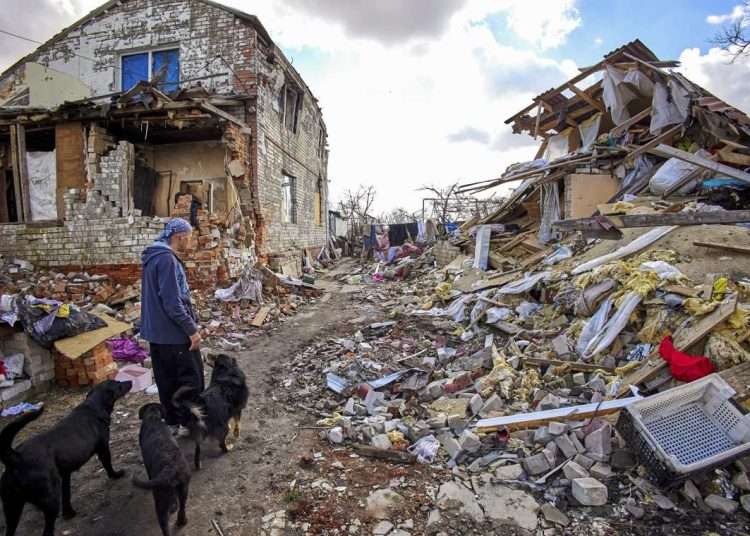The Russia-Ukraine War bears witness to hard fractures in the global hegemonic system. The material backing of currencies that is supported by natural resources, mainly oil and its derivatives, has notably reduced its fluidity between the conflicting blocs.
The first sign was the parity of the dollar with the euro in July 2022, the second, the loss of this position of the euro against the dollar, in October of that same year.
In March 2023, the fall of several U.S. banks also expressed itself as a financial weakness in Europe. While the dollar appears to be holding steady and the United States bails out failed banks quickly, Europe has run into several dead ends: the bankruptcy of the Credit Suisse Bank, the decline in the shares of the Deutsche Bank and of the stock market. But how did this complex situation come to be?
After a year of war between Russia and Ukraine, before the advances and setbacks of military positions, a great deal of the planet has felt the geopolitical movements firsthand. The increase in prices and scarcity of food and fertilizers has been global, and one of the causes of inflation.
Unexpected results of sanctions on Russia
Although Russia’s territorial objective is to consolidate itself in Donbas, for which it has politically planned popular consultations; as for the movement of capital, its master moves to overcome the economic blockade and the hundreds of restrictions have been more important.
The Russian government revealed how the dollar is tied to the price of oil and its derivatives (petrodollars), and how, given the confiscation of Russian accounts, for more than 20 billion dollars, it was forced to market hydrocarbons with Europe and other countries in rubles or yuans.
The European Union and the United States opposed the measure and announced the Russian catastrophe. A week after the decision, the ruble was recovering ground against the dollar; however, in 2023 Russia announced trade with yuans in the international market, which is also the reserve currency of the International Monetary Fund (IMF). China supported this decision, and India improved its trade relations with Russia.
The BRICS countries began to trade natural resources in their own currencies, in addition to not supporting sanctions against Russia. While Brazil (59%) and Mexico (30%) see how their countries’ Foreign Direct Investment (FDI) grows, the United States, Germany and France see it decrease. The announcement by Lula and Fernández to create a common currency has this scenario of events as its center.
The U.S. depends on the war
In the midst of the pandemic crisis (2020-2021), in the fracture of the economic system due to the great global confinement, China demonstrated that it was not greatly affected, becoming the only country, of the powers, that did not have an economic contraction. Thus China repositioned itself; things had gone well for it and the Russian-Ukrainian War opened a new fracture.
The conflict in Ukraine was divided into two sides: the United States, the European Union and NATO ― the G7 ―, as well as the rest of the Western countries in this framework; and on the other side, Russia, and commercially China, India, and various Asian, Arab and African countries.
The Ukrainian government has received support, above all from the United States, 75 billion dollars, to stay in the war. Without that monetary and military support, it would be impossible for it to withstand the aggression. Zelensky has said that the war depends on the United States; not only weapons and machinery, but also soldiers; the Ukrainian president has personally sounded it out, and he knows that U.S. bipartisanship supports the war.
Ukraine was no longer in control of Donbas before the war, and now it is difficult for it to regain its position. Ukraine has polarized between Zelensky and pro-Russian forces. Zelensky in an interview with CNN said: “We do not trust Putin” and “there can be no diplomatic solution.” The legal market for weapons of the powers has grown exponentially, at the same rate as the illegal markets that supply other wars (Syria, Afghanistan, Iraq) and drug conflicts.
And China continues to grow
The effects of the pandemic, the Russia-Ukraine War, and the crisis have affected the territorial composition of capital. In Asia, the presence of Russian and Chinese capital has increased, as in Africa. The GDP of the BRICS is already higher than that of the G7. China has managed to expand its presence in Latin America. The silk road is also a security route: for the first time, China (340) has more warships than the United States (300).
In Latin America, the strengthening of Mexico and Brazil is notable. Progressivism resurfaced in the region, the presidency of Andrés Manuel López Obrador was strengthened, and Lula changed the perspectives of Brazil. However, the economic slowdown, the increase in inflation and poverty in Latin America is palpable.
The decrease in direct trade between Latin America and Russia to numbers close to 0 strengthens Russia’s relationship with China, for indirect economic relations. If Europe’s economy has been the hardest hit in more than a year of war (except for the arms trade), Ukraine has received the worst part: 16 million displaced persons and refugees; thousands of deaths in the war; a decrease in GDP by -30.4% in 2022; the brutal drop in investments to less than a tenth; the increase in the foreign debt; the growth of inflation (25%) and poverty; the closure of schools, 40% of homes damaged and 50% of the energy infrastructure.
Contradicting Zelensky, Putin, and Biden, the only way to solve this war is through diplomatic and political means. It seems that at the end of the war, a new Bretton Woods agreement will be needed.











China is in economic peril, not reflected in the rather utopian article. No mention of the Chinese real estate bubble, equal to 3 years GDP. China’s, one child policy has drastically affected the population, so that it declined in 2022.